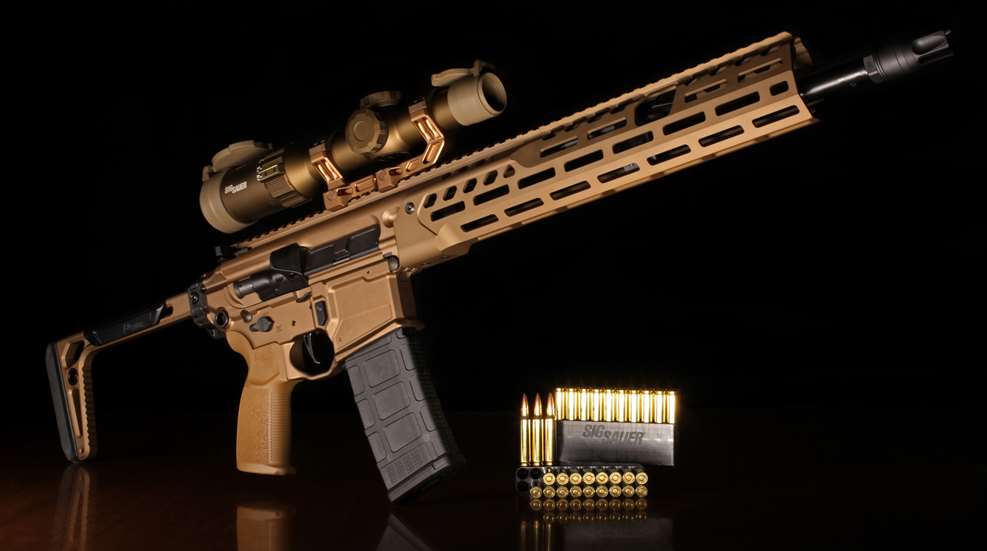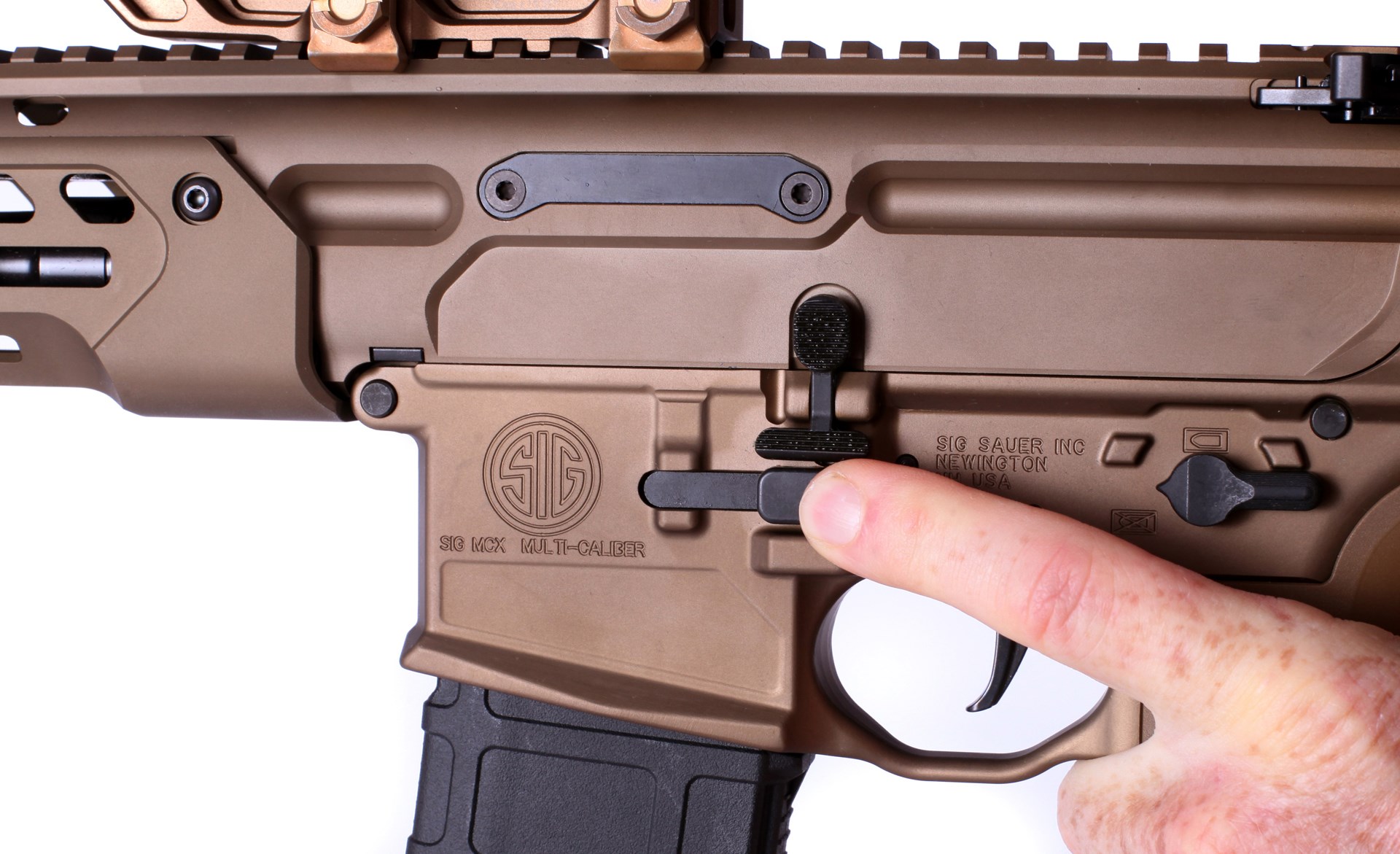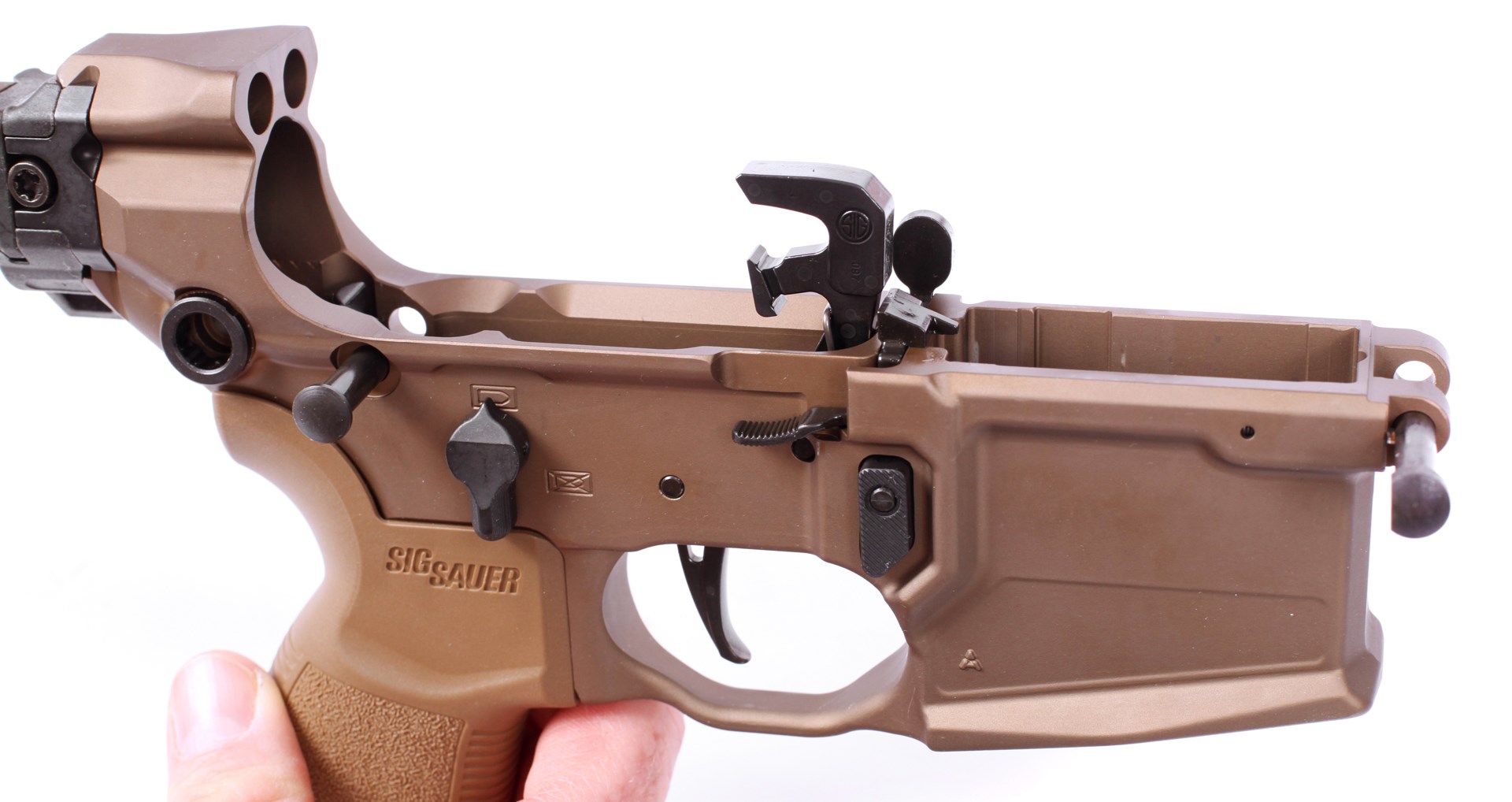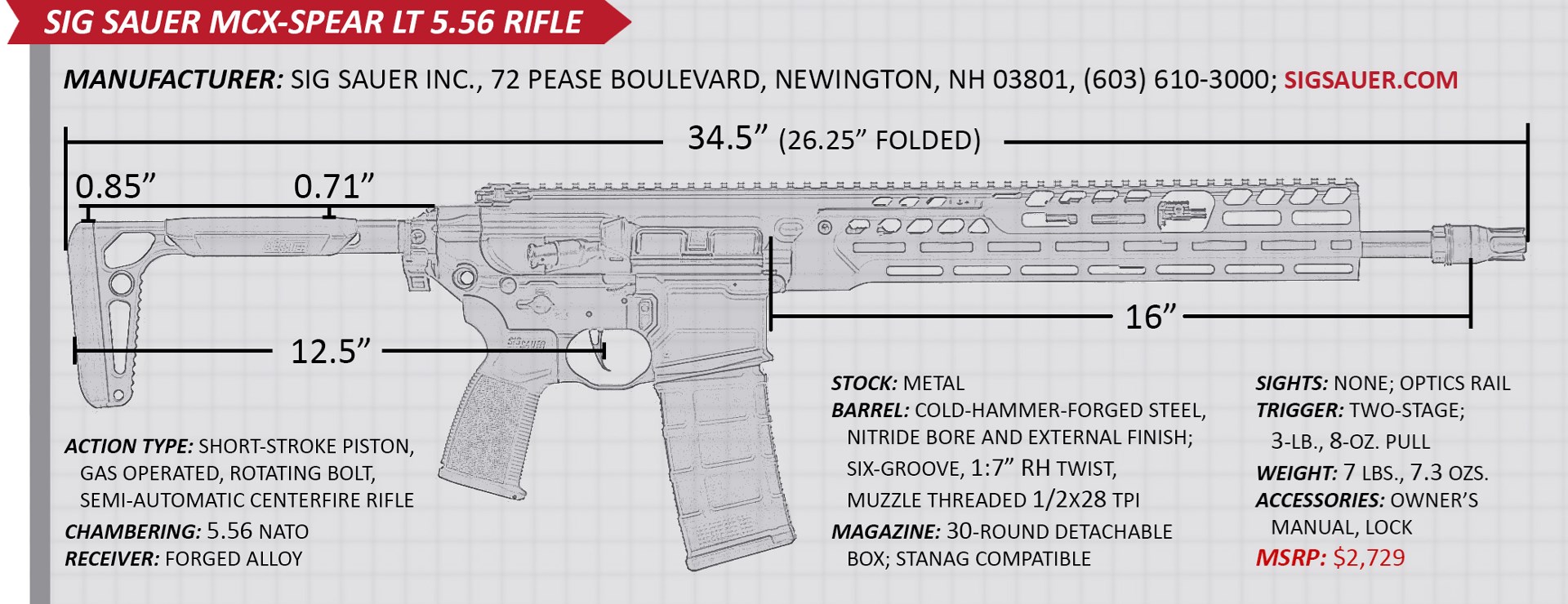
As justification for its Next Generation Squad Weapons (NGSW) program, the U.S. Army stated “…the current 5.56 cartridge has been maxed out from the performance perspective…” The program resulted in the selection of the XM7 rifle (originally designated the XM5), as designed by SIG Sauer, and a brand new 6.8 mm cartridge (read the full story of the Next Generation Squad Weapons program in the February issue of American Rifleman). In September 2022, SIG Sauer announced a new addition to its MCX line of firearms, called the “MCX-SPEAR LT,” that was based on lessons learned during the company’s successful pursuit of the Army’s Next Gen rifle contract. If the 5.56 NATO cartridge has reached its ultimate evolution, designs like the MCX-SPEAR LT beg another question. Have we also maximized the performance of the semi-automatic 5.56 mm rifle?
What does “peak rifle” look like? I would argue it is when we have reached a point that mass-produced designs are reliable and proven, they are modular and ambidextrous, they come from the factory optimized for mounting optics and suppressors and they have a user-friendly system of maintenance and repair. There are several designs that I feel fit into this classification with the MCX-SPEAR LT, including rifles like the Beretta ARX-160, CZ Bren 2, IWI Carmel and HK 433. Do these rifles represent the pinnacle of gas-operated, metallic-cartridge firing semi-automatics? To make the case for this theory, I tested and reviewed the MCX-SPEAR LT rifle in 5.56 mm and highlight how it meets each of these “peak rifle” criteria.
Reliable And Proven Design
Most modern firearms designs aren’t breaking new ground. Rifles like the MCX are based on firearms technologies that are more than 75 years old at this point. Continuing to use the MCX as an example, the multi-lug, rotating bolt-head design has its origins in the late 19th century, the multi-part, short-stroke gas-piston system was finding its way into rifles by the 1930s, and the use of forged alloys to make major firearm components was rendered mainstream by ArmaLite in the 1950s. Where designs like the MCX excel is in the combination of many proven technological features assembled into one, user-friendly platform.
 Many "peak rifles" are based on the design of the AR-18. A SIG MCX-SPEAR LT bolt and recoil spring assembly (l.), compared to a CZ Bren 2 (center) and an original ArmaLite AR-180 (r.).
Many "peak rifles" are based on the design of the AR-18. A SIG MCX-SPEAR LT bolt and recoil spring assembly (l.), compared to a CZ Bren 2 (center) and an original ArmaLite AR-180 (r.).
As with most “peak rifles,” Eugene Stoner’s handiwork lies right under the surface of the MCX, a rifle that is basically an AR-18 wrapped in AR-15 clothing. A multi-lug, rotating bolt is cammed in and out of its locked position by the action of the bolt carrier, which is operated by a short-stroke gas-piston system. The MCX-SPEAR LT uses a two-position gas regulator. The first position is for “normal” firing. The second is for “adverse” firing conditions, such as extreme cold temperatures or a very dirty firearm. The regulator can be adjusted through a port in each side of the handguard.
 The SIG MCX-SPEAR LT uses a two-position gas regulator that can be adjusted through a port in the handguard.
The SIG MCX-SPEAR LT uses a two-position gas regulator that can be adjusted through a port in the handguard.
The result of using these tried-and-true design features is a firearm that is totally reliable. The MCX has been extensively tested by military and law-enforcement agencies around the world, including adoption by the U.S. Special Operations Command (SOCOM) and the British Special Air Service (SAS), so it could almost go without saying that sample rifle should function at 100 percent during the following test.
 A proven and thoroughly tested design, the SIG MCX-SPEAR LT was 100 percent reliable in our testing.
A proven and thoroughly tested design, the SIG MCX-SPEAR LT was 100 percent reliable in our testing.
Enhanced Aiming Device Ready
M1913 Picatinny rails have been around for decades now as a method of mounting accessories, but where “peak rifles” have taken rails to the next level is by enhancing the system for reliable optics mounting. Large scopes or laser-aiming devices may not fit on the short rail section that is machined into the top of most rifle receivers. Moving aiming devices to a handguard can cause problems if the handguard does not stay in perfect alignment to the receiver in which the barrel is mounted. The SPEAR LT attacks this in two ways. First, the top of the receiver is extended, giving more space to mount an optic on the portion of the rail that is made into the receiver itself. On the MCX this rail is 11.5” long, versus the 6” rail section of a typical AR-15 receiver.
 The upper receiver of the SIG MCX-SPEAR LT features an extended rail section that allows for the forward mounting of optics.
The upper receiver of the SIG MCX-SPEAR LT features an extended rail section that allows for the forward mounting of optics.
Second, the handguard mounts to the receiver in a way that minimizes “deflection” or movement of the handguard relative to the barrel. The SPEAR LT’s unit does this in several ways. The handguard slides into grooves in the receiver. It also has a “link” that slides into the front takedown pin slot on the receiver, meaning the front receiver takedown pin is also helping hold the handguard in place. Finally, the handguard is secured in place by two tension screws. This means that secondary aiming devices that are mounted on the handguard, such as aiming lasers, can be kept in more consistent alignment, even if the handguard is taken off and put back on.
 In order to minimize deflection when using an aiming device mounted on the handguard, the SIG MCX-SPEAR LT handguard is secured to the upper receiver with a "link" (r.) that slides into a slot onto the upper receiver (l.) and is secured by the front takedown pin.
In order to minimize deflection when using an aiming device mounted on the handguard, the SIG MCX-SPEAR LT handguard is secured to the upper receiver with a "link" (r.) that slides into a slot onto the upper receiver (l.) and is secured by the front takedown pin.
The ability to utilize optics effectively also extends to the buttstock. As modern rifles are nearly always used with electronic or magnified optics, the stock design has had to evolve as well. A clip-on cheekpiece on the SPEAR LT’s minimalist stock raises the shooter’s line of sight for use with optics. Additionally, the stock is attached to a section of M1913 rail on the end of the receiver, meaning it can be changed out for different designs that have more adjustability, if necessary.
 The SIG MCX-SPEAR LT folding stock is a minimalist design with a detachable cheekpiece to aid in the use of optics.
The SIG MCX-SPEAR LT folding stock is a minimalist design with a detachable cheekpiece to aid in the use of optics.
[Relatively] Lightweight And Compact
The original M16 weighed just 6 lbs. loaded and ready for the field. Over the years, the addition of features and accessories have caused the weight of tactical rifles to climb to more than 10 lbs. in some cases.
With the MCX-SPEAR LT, “lite” refers not only to being more compact and lighter than the XM7, but also slimmer than previous generations of the MCX. Improvements to the Gen 2 MCX added weight. With the SPEAR LT, SIG sought to keep all of the updates and lose the extra weight. Without an optic, the 16”-barreled rifle comes in at 7 lbs., 7 ozs., about half a pound less than the second-generation MCX Virtus.
This weight cut comes mainly from a lightened handguard, a thinner barrel profile and subtle “lightening cuts” in the receiver surface. The SPEAR LT’s barrel profile is what would be considered a “medium” weight in the AR-15 world and splits the difference from the original MCX and the Virtus. Despite its enhanced features and short-stroke gas piston operating system, the MCX- SPEAR LT weighs nearly the same as the M4A1.
 The MCX-SPEAR LT used a barrel profile that is heavier than the original MCX, but lighter than the second-generation MCX Virtus. It approximates what would be called a "medium" profile in the AR-15 world.
The MCX-SPEAR LT used a barrel profile that is heavier than the original MCX, but lighter than the second-generation MCX Virtus. It approximates what would be called a "medium" profile in the AR-15 world.
The confined spaces of urban environments and working in and around vehicles and aircraft require a compact firearm. Unlike AR-15 designs, which require a fixed receiver extension to house the buffer and recoil spring, a design like the MCX that follows the AR-18 pattern contains its recoil springs within the receiver, allowing for a stock that folds to minimize a firearm’s overall length. The SPEAR LT stock, which is similar to the “Minimalist Plus” design offered on the MCX Rattler with a rubber cheek piece and recoil pad, unlatches with a push-button knuckle similar to what SIG uses on its Cross rifle. While the stock lacks the adjustable length-of-pull of an M4-style telescoping stock, the design is compact, simple and lightweight. It folds with the push of a button and snaps back into the deployed and locked position. When folded, the SPEAR LT is a compact package, with an overall length of only 26.25” and can be fired with the stock folded.
 The design of the MCX allows for a folding stock. The 5.56 MCX-SPEAR LT rifle is 34.50" with the stock extended (bottom) and 26.25" with the stock folded (top). Photo courtesy of SIG Sauer.
The design of the MCX allows for a folding stock. The 5.56 MCX-SPEAR LT rifle is 34.50" with the stock extended (bottom) and 26.25" with the stock folded (top). Photo courtesy of SIG Sauer.
The length of pull of the SPEAR LT, at 12.5”, is designed for use with a tactical vest or body armor, as is the steep angle of the pistol grip. For those to whom this is a problem, the Virtus telescoping and folding stock will work along with other adjustable stocks that mount to a Picatinny rail interface.
Adaptable And Modular
Both the military and civilians value a firearm that can be adapted to a variety of circumstances, accessories and user sizes. On the MCX, the pistol grip, which uses the standard AR mount, and stock can easily be swapped out. The M1913 Picatinny rail on top of the receiver and handguard, along with generous M-Lok slots on the sides and the bottom of the handguard, offer plenty of real estate to attach accessories.
With the MCX, this adaptability extends to the barrel, meaning the chambering and the length of barrel can be changed by the user. The barrel is held in place by a clamp that is secured with two torque bolts. Though SIG is not currently offering spare barrels or caliber conversion kits, we assume the company will eventually.
 The barrel of the MCX SPEAR-LT is held in place by a clamp secured by two torque bolts. This allows for barrel length and chambering conversions that can be accomplished by the end user.
The barrel of the MCX SPEAR-LT is held in place by a clamp secured by two torque bolts. This allows for barrel length and chambering conversions that can be accomplished by the end user.
Fully Ambidextrous
We have finally acknowledged that 10 percent of the world’s population is left-handed and that in many tactical shooting situations, the user needs to be able to switch firing hands and still have full functionality of their firearm’s controls. To that end, guns are now being manufactured with all controls fully mirrored on each side.
The MCX’s charging handle is the familiar AR-15 T-handle design, but with extended latches on both sides. This not only allows for the rifle to be charged with either hand, but also allows for easy charging of the rifle with a larger scope, such as a low-power variable optic (LPVO), mounted.
 The extended charging handle with dual latches allows the MCX-SPEAR LT to be charged with either hand and allows for working the action with a magnified optic in place.
The extended charging handle with dual latches allows the MCX-SPEAR LT to be charged with either hand and allows for working the action with a magnified optic in place.
The bolt release on the SPEAR LT is a design first used on SIG’s M400 Switchback rifle. This not only allows left-handed shooters to release the bolt with their non-trigger hand, but allows righties to lock the bolt open with the trigger finger of their shooting handle while working the charging handle with their support hand, an important feature for clearing malfunctions. The right-side magazine release is in the standard AR position, but enlarged. With the SPEAR LT, the left-side magazine release has been repositioned and is shielded. The A2-style case deflector means that empty brass is ejected in a direction that is safe for firing from the right or left shoulder.
 A new feature for the MCX line, the SPEAR LT has a right and left side bolt catch lever, a design adopted from the SIG M400 Switchback.
A new feature for the MCX line, the SPEAR LT has a right and left side bolt catch lever, a design adopted from the SIG M400 Switchback.
 The layout of the SIG MCX-SPEAR LT receiver and controls (bottom) is very similar to the M16/AR-15 family (top).
The layout of the SIG MCX-SPEAR LT receiver and controls (bottom) is very similar to the M16/AR-15 family (top).
 Controls on the SIG MCX-SPEAR LT are mirrored on both sides, with a magazine release, safety and bolt catch lever on each side of the rifle.
Controls on the SIG MCX-SPEAR LT are mirrored on both sides, with a magazine release, safety and bolt catch lever on each side of the rifle.
 The MCX-SPEAR LT adds a bolt catch lever to the ride side of the rifle (l.). This allows the right-handed trigger finger to manipulate the bolt catch.
The MCX-SPEAR LT adds a bolt catch lever to the ride side of the rifle (l.). This allows the right-handed trigger finger to manipulate the bolt catch.
Suppressor Ready
The use of suppressors is becoming more common in both civilian and military worlds, with the Army’s next-generation rifle and squad automatic weapon both designed to be used with a suppressor in most situations. For a rifle to be used with a suppressor, it needs both a method of attachment and an action designed in such a way that it functions reliably when using the suppressor. The SPEAR LT is suppressor-ready right out of the box. It can be fired suppressed or unsuppressed with the gas regulator in the “normal” position. As a suppressor generates more back pressure into a firearm’s action, the SPEAR LT’s use of a short-stroke gas piston operating system keeps more debris and hot gases out of the action when using a suppressor than the simpler direct gas impingement design of the AR-15.
The SPEAR LT’s muzzle is threaded 1/2x28 TPI for use with common AR-style 5.55 mm muzzle devices and comes with a SIG “Rocksett” QD suppressor-ready flash hider installed. The simple three-prong design is not the most effective muzzle device, but this rifle is intended to be used with a suppressor installed.
 The SIG MCX-SPEAR LT comes equipped with a SIG "Rocksett" QD suppressor-ready flash hider. The muzzle of the barrel is threaded 1/2 x 28 TPI.
The SIG MCX-SPEAR LT comes equipped with a SIG "Rocksett" QD suppressor-ready flash hider. The muzzle of the barrel is threaded 1/2 x 28 TPI.
Low Maintenance/Extended Service Life
Field-stripping the MCX, with its two takedown pins that hold upper and lower receivers together, will come easy to anyone familiar with the AR-15/M16 family. The process is nearly identical until you get to the bolt assembly. Here you will notice some improvements. The firing pin retaining pin is captured. The extractor is held in place with a standard machine pin that is captured when the bolt is inserted in the carrier, instead of a roll pin, making cleaning and extractor spring maintenance a breeze.
 The SIG MCX-SPEAR LT disassembled for cleaning and maintenance.
The SIG MCX-SPEAR LT disassembled for cleaning and maintenance.
 The disassembled SIG MCX-SPEAR LT bolt, carrier and recoil spring assembly. The design uses a captured firing pin retaining pin and a simple machine pin that holds in the extractor for ease of maintenance.
The disassembled SIG MCX-SPEAR LT bolt, carrier and recoil spring assembly. The design uses a captured firing pin retaining pin and a simple machine pin that holds in the extractor for ease of maintenance.
The upper and lower receivers are of forged alloy with steel inserts in critical high-wear areas, such as the case deflector/forward assist assembly, the cam-pin track for the bolt carrier, feed ramps and the locking points for the charging handle, meaning these pieces can be swapped out to extend the life of the receiver. Steel inserts are also used the in the quick detach sling swivel sockets.
 The SIG MCX-SPEAR LT uses a forged alloy upper receiver with replaceable steel inserts in critical high wear areas, such as the forward assist/case deflector, cam-pin track, and feed ramps to extend the life of the receiver.
The SIG MCX-SPEAR LT uses a forged alloy upper receiver with replaceable steel inserts in critical high wear areas, such as the forward assist/case deflector, cam-pin track, and feed ramps to extend the life of the receiver.
How Is The SPEAR LT Different Than Previous Generations Of The MCX?
SIG introduced the MCX series in 2015, and the SPEAR LT represents the third “generation” of the MCX family, following the original model and the second -eneration Virtus models introduced in 2018.
Along with the fully ambidextrous controls, the SPEAR LT introduces the SIG Flat Blade two-stage match trigger to the MCX design. While much nicer than “mil-spec,” the trigger was somewhat lacking in crispness before breaking at 3 lbs., 8 ozs. If the stock trigger is not to your liking, the SPEAR LT is compatible with most AR-15 and previous-generation MCX trigger systems.
 The SIG MCX-SPEAR LT is provided with a flat-blade, two-stage match trigger that breaks at 3 lbs. 8 ozs.
The SIG MCX-SPEAR LT is provided with a flat-blade, two-stage match trigger that breaks at 3 lbs. 8 ozs.
With the SPEAR LT, for the first time, a firearm in the MCX family is available in 7.62x39 mm. SIG emphasizes that the MCX-SPEAR LT is not an AR-15 system adapted to 7.62x39 mm, but a system designed from the ground up to handle the 7.62 mm Russian cartridge. The design has been optimized specifically to overcome feed problems common to AR-15-style rifles that chamber the Russian round and also has an improved hammer spring to deal with the hard primers associated with imported ammo.
 In another first for the MCX line, SIG is offering the MCX-SPEAR LT in 7.62x39 mm in rifle, SBR and pistol form. The 11.5"-barrel pistol version pictured. Photo courtesy of SIG Sauer.
In another first for the MCX line, SIG is offering the MCX-SPEAR LT in 7.62x39 mm in rifle, SBR and pistol form. The 11.5"-barrel pistol version pictured. Photo courtesy of SIG Sauer.
SIG claims “improved accuracy” for the SPEAR LT. In our 2018 evaluation of the MCX Virtus Patrol, accuracy averaged just over 2.5”. In testing the SPEAR LT, average accuracy was just over 2” for five shot groups at 100 yards, with SIG’s Elite Performance ammunition producing groups that averaged 1.67".
 SIG claims improved accuracy with the MCX-SPEAR LT. Our test rifle averaged five-shot groups of just over 2" at 100 yards, with SIG's own Elite Performance ammunition producing groups of just over 1.5".
SIG claims improved accuracy with the MCX-SPEAR LT. Our test rifle averaged five-shot groups of just over 2" at 100 yards, with SIG's own Elite Performance ammunition producing groups of just over 1.5".

The MCX-SPEAR LT is offered in rifle, short-barreled rifle (SBR) and pistol configurations. Rifles have 16” barrels and are offered in 5.56 NATO and 7.62x39 mm. Pistols and SBRs are available in 5.56 NATO and 7.62x39 mm with an 11.5” barrel and .300 Blackout with a 9” barrel. SBRs come equipped with the same stock as the rifle (all NFA rules apply). All MCX-SPEAR LT models, including the pistols, have a section of Picatinny rail on the rear of the receiver for attaching accessories. The entire SPEAR LT lineup is available only with a coyote-brown anodized finish with black anodized accents.
 The SIG MCX-SPEAR LT lineup will include pistols (not shown), short-barreled rifles (SBRs) and rifles in 5.56 NATO, 7.62x39 mm and .300 Blackout. Photo courtesy of SIG Sauer.
The SIG MCX-SPEAR LT lineup will include pistols (not shown), short-barreled rifles (SBRs) and rifles in 5.56 NATO, 7.62x39 mm and .300 Blackout. Photo courtesy of SIG Sauer.
How Is The SPEAR LT The Same/Different Than the XM7?
While the XM7 is based on a mid-size action to accommodate 7.62 NATO-class cartridges, the MCX-SPEAR LT uses a 5.56 NATO, AR-15-size action. So, besides its caliber and overall size, how does the SPEAR LT differ from its Army-issue big brother? The XM7 uses a 13” barrel and has a left-side, non-reciprocating charging handle, in addition to an ambidextrous AR-type charging handle. The SPEAR LT ditches the side-mounted charging handle and only has the ambidextrous rear charging handle.
 The SIG MCX-SPEAR LT (top) is derived from lessons SIG learned during the process of winning the U.S. Army's Next Generation Squad Weapons (NGSW) competition with its MCX-SPEAR (bottom), adopted as the XM7.
The SIG MCX-SPEAR LT (top) is derived from lessons SIG learned during the process of winning the U.S. Army's Next Generation Squad Weapons (NGSW) competition with its MCX-SPEAR (bottom), adopted as the XM7.
While SIG has already offered a semi-automatic version of the XM7 as the “MCX-SPEAR,” its $8,000 price tag and NFA restrictions will keep it out of the hands of most. The MCX SPEAR-LT is more affordable, with the rifle version tested here having an MSRP of $2,729.
Conclusion
Is there room for improvement with self-loading rifles? Sure. We continue to experiment with innovations like caseless and case-telescoping ammunition, find new materials to incorporate into firearms designs and try to re-invent the semi-automatic rifle “wheel” to gain even the smallest performance advantage. There may even be a quantum leap in firearms technology on the way that isn’t on our radar yet. But until the Star Trek phaser becomes available in the real world, within the limits imposed by metallic-cased ammunition, firearms like the MCX- SPEAR LT represent a pinnacle where reliability, modularity and ease of use have been maximized.




































